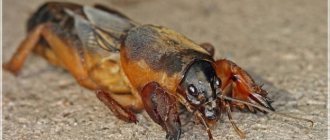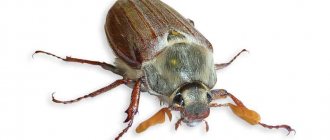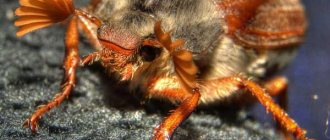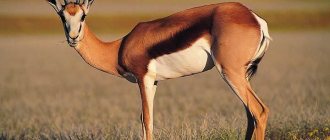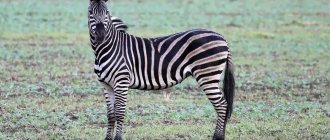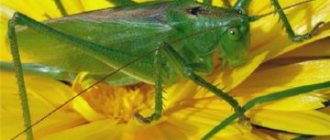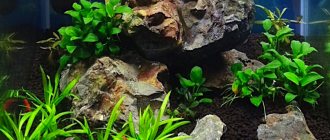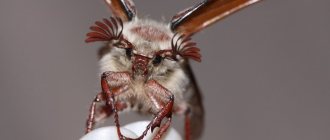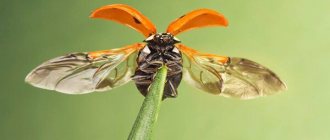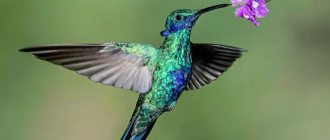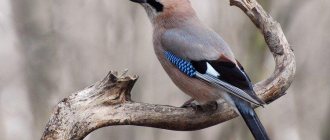Everyone has seen the cockchafer or the cockchafer, or at least heard of it, that’s for sure. With the onset of spring, these large insects on quiet warm evenings, with their wings spread, circle with a roar above the tops of flowering trees. Remember how it was in Taras Grigorievich: “The Khrushchevs are buzzing over the cherries...”.
Unfortunately, these robbers “buzz” only when they go in search of succulent flower buds, greedily eating the insides of flowers and young leaves, thus causing irreparable damage to fruit trees, shrubs and other cultivated plants.
In the middle of the last century, when pesticides began to be actively used to combat colonies of harmful insects in agriculture, the population of cockchafers sharply decreased. But after 1980, due to the ban on the use of outdated chemicals, the growth in the number of beetles quickly increased, and soon their numbers again reached a critical level.
But the May beetle itself or Khrushchev ( lat. Melolonthinae
) – this is only half the story. The trouble is its ugly, voracious larva, which in Ukraine is called a hrobak.
What harm does the cockchafer cause?
The victims of adult beetles are mostly fruit trees and shrubs, where they actively eat young leaves. They are not attracted to grasses and low-growing herbaceous plants. In the years of mass summer of cockchafers (they happen once every 3-5 years), during a short period of their activity they are able to gnaw all the leaves of garden plants over a large area. In other years, their years may pass almost unnoticed.
And the larvae growing in the soil actively spoil the roots of garden and vegetable crops (including root crops) throughout the growing season. Because of them, lawn grass withers, and strawberries often suffer.
The gluttony of these soil caterpillars is such that at 2 years of age it can gnaw off the roots of a pine seedling of the second year of life in a week, and the next year it can cope with it in one day
External structure
Head
The mouth and sensory organs are placed on it. The mouth consists of jaws and lips - above and below. On the lower ones there are organs of taste and touch in the form of small palps. At the top of the head on the sides are the eyes, which have a complex facet structure.
Above them are antennae ending with 7 plates. The latter are the organs of smell. The entire head is pressed into the prothorax, causing it to tilt downward and not rotate laterally .
Breast
Divided into 3 sections - rear, middle and front. Each has a pair of legs (6 in total), and there are wings . On the dorsal side, the chest is hidden behind the elytra . They protect the soft covers of the back and thin hind wings from damage.
The front wings are much stiffer, so they do not require protection. With its feet, the cockchafer excels at clinging to branches and shoots and them well
The legs are not designed for dexterous walking on flat surfaces, so in such places the beetle moves slowly and awkwardly .
Abdomen
It has a fixed connection to the chest and includes 8 segments. From the back on the sides of the abdomen there are respiratory openings .
External structure of the May Khrushchev - photo:
Stages of development of Khrushchev
The cockchafer is a fairly large insect. Its body reaches up to 35 mm and is colored black or red-brown. In nature, they inhabit forest-steppes and forests, mainly light coniferous (pine).
In the spring (usually in May) the beetles begin breeding. After mating, the females burrow into the soil and lay eggs. One female May beetle lays up to 70 eggs and then dies. After 1-1.5 months, large, white, quite mobile larvae hatch from the eggs. They are easy to distinguish from other pests, as they seem to be curled into a ball.
Khrushchev larvae live in the soil for 3 to 4 years, and then turn into motionless pupae, which are similar in appearance to adult beetles. The final stage of development of the cockchafer is the imago, when the pupae turn into beetles. This process occurs in late summer or autumn. Young beetles emerging from pupae overwinter in the soil and emerge to the surface in the spring.
Under favorable weather conditions in nature, the population of cockchafers increases, accompanied by a massive flight. The peak number of May beetles is observed 20-25 years after a 3-4 year break in their activity. Right now (that is, these years) there is a peak in the reproduction of these pests. It is believed that this activity can last about 10 years, so it is important to know how to control this pest to reduce the damage it causes.
What does the cockchafer eat?
Khrushchev, like most insect pests, poses a double threat, since damage is caused not only by adult beetles, but also by their larvae.
If beetles eat leaves mainly within 1-2 months during the flight and reproduction period, then the larvae are more voracious and dangerous. Adult beetles eat the leaves and flowers of fruit trees and shrubs: cherry, plum, sea buckthorn, black currant and apple trees are some of the most favorite trees for cockchafers. But they also love to eat leaves of ornamental trees: aspen, maple, birch, etc.
But this is what the larvae of the cockchafer eat... They gnaw the roots of strawberries, various vegetable crops, fruit trees and shrubs. They like potato tubers and corn roots. They also like to eat the roots of pine, cedar, birch, larch, and spruce. They do not disdain the roots of lawn grass. Older larvae are more voracious than their younger relatives. There is information that one three-year-old larva can eat the roots of a 2-year-old pine tree in one day. But for a 2-year-old larva, the roots of the same tree will last for a whole week. This doesn’t make it much easier for us.
note
According to the Main State Plant Protection Inspectorate, in recent years, cockchafers remain dangerous phytophages in all zones of Ukraine, but are most numerous and harmful in the Polesie and Forest-steppe zones of Ukraine. During the period of mass summer in most regions (Zhytomyr,
Volyn, Ivano-Frankivsk, Rivne, Chernihiv, Vinnitsa, Kiev, Sumy) beetles damage from 9 to 35% of fruit, ornamental and other plantings, in some places in the Ivano-Frankivsk region - up to 60%.
During the growing season, cockchafers damage an average of 2.5-12.0% of plants in agricultural crops.
There is a particularly high level of damage to crops (up to 25-35%), located near forests and shelter belts, which are the main source of accumulation and spread of the pest. With a good overwintering in all regions of Ukraine, there remains the threat of an increase in the number and harmfulness of adults and larvae of the May and June beetle in the areas of perennial fruit and forest plantings, vineyards, crops, in household plots bordering forests, forest plantations and unplowed lands.
Reproduction of the lamellar family
From the end of May, beetles begin to actively reproduce. After the “weddings,” the female lays the first 20–30 eggs in the roots of the plants. Buries them and returns to continue mating. During the season, one female brings offspring 3–4 times, and in total the number of eggs reaches 40–60, or even 70 pieces. After this, the mother dies, and the children do not need her further presence.
- After a month or a month and a half, the eggs are opened, and larvae emerge from them - large, plump, with a large mouth. For the next three years, in this state, the insect will actively develop, going 1.5 m deeper in the winter, and returning to the upper layers of the soil in the spring.
- In the 3rd year (in southern latitudes) or 4th (for regions with a harsh climate), the larva enters the pupal stage in mid-summer, and this period lasts for about a month and a half.
- Then the pupa turns into an adult beetle, and continues to remain dormant until spring.
- In April - May, when a tunnel is broken, males come to the surface, then females catch up with them. And the cycle begins again: mating, feeding, laying eggs, death of the female, and then the male, development of the larva.
Behavior
Adults appear in spring at the end of April or beginning of May. In May there is a period of their mass flight, for which they got their name. Having emerged from their underground shelters after a long winter, the beetles perform a kind of gymnastics - they briskly move their antennae and actively raise and lower their elytra. Having warmed up well and feeling the brave prowess in their bodies, they soar into the air.
Entire hordes of May beetles, filling the surrounding space with a characteristic roar, rush to the crowns of deciduous trees. With particular frenzy they devour buds and young greens. They are especially not indifferent to oak leaves, but also feed on the leaves of birch, willow, maple, chestnut, hornbeam, beech and some types of poplars. They are not averse to gnawing on pine needles, leaning on the inflorescences of spruce, fir and pine trees.
Gluttons fly exclusively on warm summer evenings, and at the slightest cold snap they fall into torpor.
Lifespan
The development of the cockchafer is long, but its full existence is short. The total life cycle reaches 5 years, of which only one is summer (about 2 months), the beetles are active.
Let's take a closer look at the life stages of a beetle:
- 30 - 40 days - egg stage;
- 3 − 4 years - larval stage;
- 1.5 − 2 months. - pupal stage;
- imago (full-fledged beetle) - about a year, of which the insect is awake for only 5 - 7 weeks.
During this entire cycle, the family living in the roots of the plant can completely destroy the adult tree. Therefore, people actively use chemicals to combat Khrushchev.
Prevention
If you carry out preventive work on time, you can get rid of these pests. The main methods of these, if your area is not yet affected:
- Treating the row spacing of your crops.
- Watering the plants themselves with solutions.
- Tilling the soil under the bushes.
If the area has been damaged:
- Dig the soil deeply (at least 40 cm deep).
- You can install a birdhouse.
- For prevention in the spring, pour a solution of ammonia or karbofos under the bushes.
- In autumn, the ground needs to be treated with bleach or “White”.
- Mulch the soil. To do this, you can take straw, wood shavings, and bark.
Pest control is very difficult. Because when you dig up the ground, you may not see the eggs of these pests. Over time, larvae will appear from them again.
If you have not seen these pests in your area before, this does not mean that they did not exist at all. Their development period takes 3-4 years. It is advisable, upon seeing a damaged bush, to immediately dig it up and carefully inspect it. This way you can see the larva. Damage is usually noticeable in late spring.
Unlike other pests, these lead to complete drought of the crop and the death of bushes and fruit trees.
Remember, one 2-year-old larva can completely destroy a young tree seedling, 18 strawberry bushes, 5 currant bushes and all planted seedlings in one season. At the age of 3 years, the pest destroys 3 times more crops. And when it’s already full-fledged, it eats up the entire harvest.
Timely prevention will help you prevent re-infection with larvae. If you notice that your area is prone to pests in early spring, provide proper protection and you will end up with a healthy harvest.
Fighting the cockchafer using traditional methods
During the period of the highest activity of the insect, that is, with the appearance of adult individuals, they can be caught by shaking them from trees and bushes. It is best to do this early in the morning, when the cockchafer is in a torpor due to the overnight drop in ambient temperature. Searching for the May beetle for collection and destruction You can also reduce the number of the beetle and its larvae using homemade traps: A shallow container (plastic or metal basin) is dug into the ground in an open area near areas with vegetation or trees and smeared from the inside with grease or special glue for insects
At night, a light source of medium power is installed at the bottom of the basin prepared in this way. In the morning, you will have to dispose of an entire army of insects with your own hands, including many individuals of the cockchafer, which ran up and flew into the light and successfully stuck to the walls of the trap. The neck is cut off from a regular plastic bottle, and 4 holes are made in the walls around the circumference. A cord is threaded through them, by which the trap is suspended among the branches of fruit trees. Then pour a little bread kvass or fermented jam into the bottom. Traps should be checked regularly, adding bait liquids and removing dead insects. Soap trap for beetles Under the lamp, fixed among the branches of garden trees, there is a small container of water, into which a little kerosene should be added.
Trap for the cockchafer The destruction of the cockchafer can be entrusted to poultry. Of course, you shouldn’t let it out into the garden, otherwise the vegetation will be destroyed along with the pests. However, there is no quicker way to get rid of hand-collected larvae and dead adult beetles than by pouring them into a chicken feeder. If walnuts grow on your site, you can safely include a decoction of its leaves in your arsenal of means to combat beetleworm and its larvae.
Other types of mouthparts
Filter type
The described varieties belong to the main types of mouthparts, however, among smaller and less numerous orders there are also other modifications. For example, some aquatic larvae, in particular the larvae of many midges (Simuliidae), develop a kind of fan on their heads designed to filter microorganisms. Based on the mechanism of operation, this type of apparatus is called filtering. [4]
Cutting and sucking type
Horseflies (Tabanidae) and some other dipterans have a cutting-sucking type of mouthparts: the mandibles are elongated into sharp blades, and the maxillae are elongated into long piercing stylets. Both pairs of jaws cut and pierce the integument of the body of mammals, causing bleeding from the wound. This blood is collected by a sponge-like structure on the lower lip and delivered to the apex of the hypopharynx. The epipharynx and hypopharynx are tightly adjacent to each other, creating a tube through which blood rises into the esophagus. [4]
Tubular-sucking type
Adult Lepidoptera feed on nectar and other liquid food. It is absorbed through a long proboscis formed by the galea and maxillae folded together. The result is a tube that opens into the esophagus. This type of structure is called the tubular-sucking type of mouthparts. [4]
Chemical methods of pest control
The use of heavy insecticides should be avoided. Together with the pest, they will also destroy beneficial insects, for example, bees, without which the reproduction of flowering plants is almost impossible, and will also scare off its natural enemies - birds, amphibians and predatory insects. You can protect the area from the invasion of the cockchafer in the following ways: mulching the soil with crushed tree bark, chopped straw or wood shavings and sawdust, which makes it difficult for the insect to penetrate the soil to lay eggs; Mulching the soil with straw aromatically repels the pest - it does not tolerate the smells of elderberry, lupine, representatives of the cruciferous family, turnips, mustard, wormwood, turnips, etc.
"Bazudin"
Made in Switzerland. The active ingredient is diazinon, which requires careful use and compliance with safety measures.
In addition to beetle larvae, Bazudin is also effective against wireworms and some other harmful insects. It has Russian analogues, these are “Grom”, “Kapkan” and “Dohloks”.
Carefully! “Bazudin” is a dangerous substance for fish and other inhabitants of water bodies, so it should not be allowed to get into ponds and rivers!
"Zemlin" and "Pochin"
They also work against several groups of insects that cause damage to crops. To get rid of the “May” offspring, sawdust or dry sand is poured into a 0.5 liter jar, after which you need to add one package of the product and mix the contents well. Used when transplanting seedlings to protect them. Add 1 tsp to each planting hole. the resulting composition.
"Aktofit"
It is an insectoacaricide with contact effects on the digestive system. It works due to natural inhibitory toxins with a specific focus. Once in the insect’s body, it affects its nervous system and causes death.
"Antikhrushch"
Made in Ukraine. Insectoacaricide, which is a systemic 2-component contact disinfectant. Effective against several types of insects that damage crops. Like Actofit, it blocks the functioning of the nervous system, causing the death of individuals at all stages of formation.
General characteristics of the class
They live in soil, water, plant tissues, animals and humans.
Types of mouthparts:
Vision is complex (faceted). A person distinguishes about 60 individual colors; bees see yellow, blue-green, blue, ultraviolet (butterflies see red).
The shape of objects is distinguished - predatory (dragonflies, cetaceans); social (ants, bees, wasps).
The sense of smell is on the antennae (butterfly - 2-3 km).
Taste organ on the mouth parts (jaws, lips, palps). Just like humans, they distinguish between sweet, sour, salty, and bitter.
Sense organs are well developed and provide insects with great information about the external environment.
Mechanical methods of struggle
Catching flying, adult beetles is not very difficult and is the most effective (at this stage) and reasonable. This can be done as follows.
Light traps
A light source is placed in a container coated from the inside with a viscous substance, such as grease. In calm weather it can be a candle. Late in the evening, when it gets dark, the trap is taken out into the garden and the lights are turned on. The beetles will flock to the light and get stuck in the thick substance.
Sticky paper
Newspapers are well suited for this; on one side they need to be coated with any non-drying adhesive composition. Then they are laid out on the beds (a particularly good “harvest” can be collected from strawberries) or hung on trees.
Collecting larvae by hand
Fighting Khrushchev caterpillars is much more difficult than fighting flying individuals. Their mechanical collection is long, labor-intensive and must be done in an area free from crops in the warm season, before they go to the depths for the winter. When digging a plot in the summer, most of them can be found and collected at a depth of 10-20 cm. However, some of them live much deeper, up to 0.5 m, and getting to them with a shovel is much more difficult.
Sodding an area with white clover
The method is based on the fact that soil nitrogen is destructive for Khrushchev. Therefore, planting plants that actively accumulate nitrogen from the air and synthesize it into the soil is an effective method of pest control. In particular, such a plant is white clover. For fruit crops, nitrogen, on the contrary, is very useful and has the ability to increase the yield and quality characteristics of fruits. In particular, experienced farmers recommend planting white clover around the trunks of fruit and berry trees and shrubs. A bonus is that clover inhibits the growth of weeds and makes the soil more fertile.
Help from insectivores
First of all, these are birds, for example, starlings. You can attract them to your site by building birdhouses. The risk of birds damaging crops can be mitigated in other ways, but there will be significantly fewer pests in the surrounding area.
It is especially good if hedgehogs settle on the site, who know how to hunt and love to feast on the beetle and its caterpillars, finding them in the ground. You don’t need to try too hard to attract hedgehogs; our dachas are a wonderful home for them. The main thing is not to interfere with their life and reproduction, maintain silence, and sometimes feed these garden workers.
Biological drugs
A relatively new direction in the fight against soil pests based on natural biological processes that are harmless to humans.
"Nemabakt"
It is one of the most popular biological drugs. It is a bioinsecticide based on a parasitic insect (entomopathogenic) nematode.
This is a tiny round worm that lives in soil layers and feeds on larvae. Due to its microscopic size, it easily penetrates inside through the natural openings in it, where it feeds and reproduces, quickly leading to the death of the caterpillar. And after a few days, thousands of offspring crawl out of the dead individuals, looking for new victims.
Entomopathogenic nematodes are completely safe not only for humans, but also for animals, beneficial insects (in particular, bees), fish and even earthworms.
"Boverin"
Another new generation insecticide with biological effects. This time, an entomopathogenic fungus comes to the benefit of a person, which has the ability to germinate in the tissue of the larva, filling its cavity with a growing structure and releasing toxins that are harmful to the insect. After the death of the embryo, many spores remain on its surface, which infect other, still healthy individuals. In a fairly short time, the entire colony is destroyed.
Modifications of the oral apparatus
In different groups of insects, the oral apparatus has been modified to better absorb different types of food in different ways. The most specialized and varied types of mouthparts are listed below; they are chosen to demonstrate the richness of the forms assumed by homologous parts and the different ways in which they are used. There are also many other types, and they often represent transitional stages between the types we are considering here. [4]
The type of mouthparts is a systematic character at the order level. In smaller taxa, there are usually no differences in this character: as a rule, only some individual structural features are found. [2]
Gnawing mouthparts
1 – Structural diagram 2 – Mouthparts of the beetle Prionus californicus from the longhorned beetle family
Designations in both pictures: VG - upper lip, NG - lower lip, HF - upper jaws, LF - lower jaws.
Gnawing type
Typical owners of the gnawing apparatus can be locusts and lepidopteran larvae - caterpillars. [4]
This type of organization is primary. It is this variant that contains the most complete set of oral parts - the upper lip and three pairs of oral limbs: mandibles (upper jaw), maxilla (lower jaw) and labium (lower lip). [2]
The leading role in food intake is played by the upper jaws, which bite off and crush the substrate, and the remaining oral parts help swallow it, pushing the pieces into the esophagus. [4]
Sucking mouthparts
1 – Structure diagram 2 – Mouthparts of a butterfly
Designations in both pictures: VG - upper lip, NG - lower lip, LF - lower jaws (proboscis).
Sucking type
This type of oral apparatus is found only in representatives of Lepidoptera.
Its main part is called the proboscis, which is a modified pair of lower jaws. The upper and lower lips look like plates located above and below the proboscis, and butterflies do not have upper jaws at all. [3]
Nutrition is carried out as follows. At rest, the proboscis is curled under the head, and during feeding it expands into a long tube that can penetrate inside the corolla of the flower. The insect sucks in nectar through this tube. [3]
Licking mouthparts
Licking type
The licking type of mouthparts is common among flies.
Its main part is the hypertrophied lower lip. It is modified and, with the participation of reduced structures of the remaining oral parts, forms a proboscis. [2]
During feeding, the proboscis is immersed in liquid food, which rises into the esophagus through capillary tubes. Flies are also capable of absorbing soluble nutrient substrates by first secreting a drop of saliva on them and then sucking up the resulting liquid. [4]
Piercing-sucking mouthparts
1 – Structural diagram, 2 – Oral apparatus of the mosquito Culex tarsalis.
Designations in both pictures: VG - upper lip, NG - lower lip.
Piercing-sucking type
This modification of the oral apparatus is found in aphids, scale insects, mosquitoes, bedbugs and other insects that feed on the juices of plants, other representatives of their class or the blood of animals.
In the piercing-sucking apparatus, the upper lip and both pairs of jaws are transformed into a needle with a lumen inside, and the lower jaw is modified and surrounds this needle in the form of a case, forming another version of the proboscis. [4]
To take food, the insect presses its proboscis against the integumentary tissues of a plant or animal, and then inserts a needle into its tissue and sucks juices into the esophagus. [4]
Gnawing-licking mouthparts
1 – Structural diagram 2 – Mouthparts of a honey bee.
Designations in both pictures: VG - upper lip, NG - lower lip, HF - upper jaws, LF - lower jaws.
Gnawing-licking type
The gnawing-licking type is characteristic of Hymenoptera.
The upper lip and upper jaws of bees and wasps are almost the same in structure as in a typical gnawing apparatus, and the maxillae and labium have been transformed into a retractable groove-like organ. [4]
Feeding occurs by lowering the latter into the nectaries of flowers. Through the smallest channels in its thickness, saliva descends, and dissolved food moves upward. [4]
Planting lupine for preventive purposes
Lupine is an excellent green manure that improves the quality characteristics of the soil, promotes its aeration, saturates it with nitrogen and prevents the growth of weeds. And since there will be no weeds in the plot where it is planted, the larvae will not get anything for “lunch” except the roots of the lupine itself, which for them is pure poison!
People's advice often mentions bleach, which actually works against the beetle, but the priority should always be the feasibility of one method or another, and in the case of chlorine it is questionable. Many gardening crops do not tolerate such “feeding” well, which is why in agricultural technology there are restrictions on the addition of even beneficial potassium chloride. But mulching the soil during crop growth and sowing green manure after harvesting will benefit fruiting, make the farmer’s work easier, and an excellent preventive measure against pest beetles.
Interesting facts about the cockchafer
This creature is interesting not only for its beautiful appearance. The insect puzzled even scientists because:
- In principle, it should not fly; it has insufficient lifting force. But, despite all the laws of aerodynamics, the beetle flies, and even very quickly.
- Anyone can envy Khrushchev's determination. It is simply impossible to disorient him. If the insect has identified a target, then the only way to prevent it is by killing it. Catch it, release it somewhere else, treat it with chemicals or turn it around. Returning to the wild, having recovered from the effects, the beetle will return to its previous course!
- In the third year, the larva is so voracious that in one season it can devour the entire root of a pine tree at the age of two years.
Perhaps someday the research work of scientists will be able to reveal the secrets of this beautiful insect. But for now it remains a mystery. Watching the cockchafer can be very exciting. Its appearance heralds the arrival of spring, and this cannot but rejoice. But still, do not forget that Khrushchev is a great pest of our forests and vegetable gardens, and its excessive reproduction destroys wild nature and cultivated plants.

